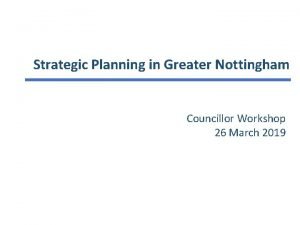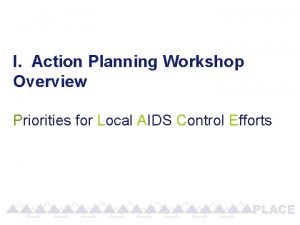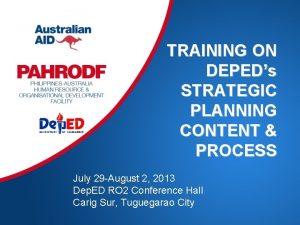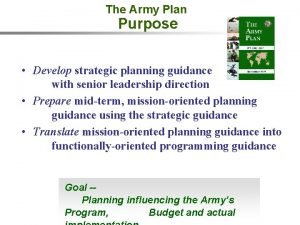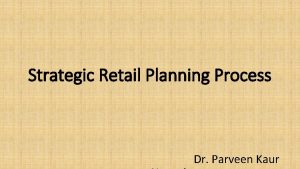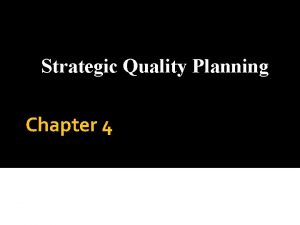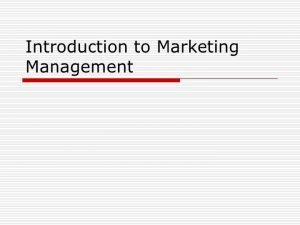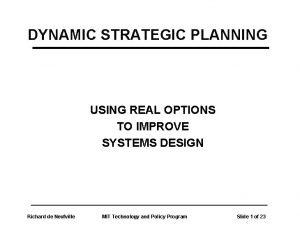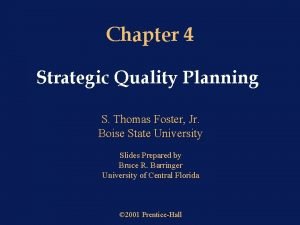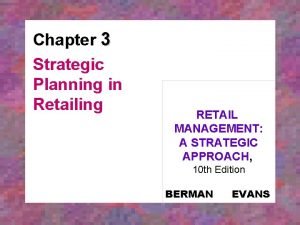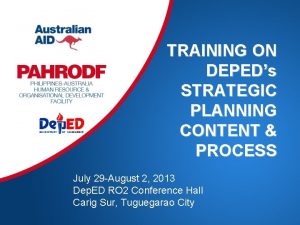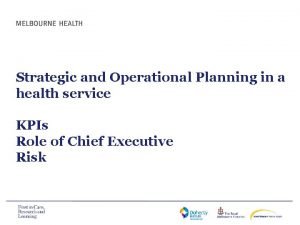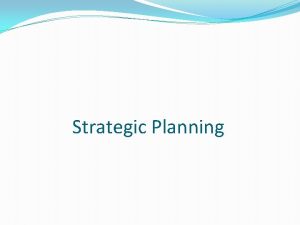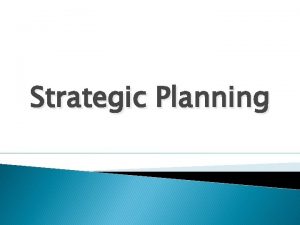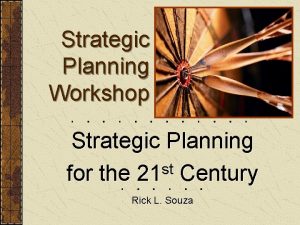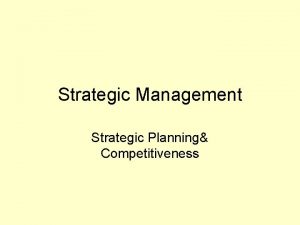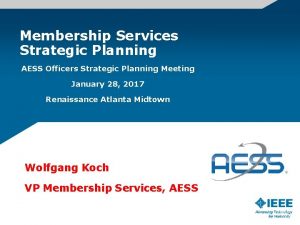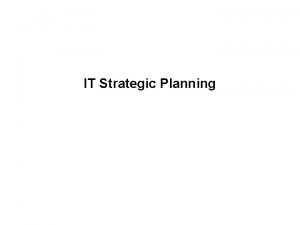STRATEGIC PLANNING workshop What is a strategic plan






































- Slides: 38

STRATEGIC PLANNING workshop What is a strategic plan? Why is it important? Below are some of the questions that will be addressed in this workshop. By the end of the workshop, you will be able to answer all these questions, and you will have a focus for your strategic plan. Important terms are underlined below. You will learn all about these. • Defining a strategic plan. What is it? What does it achieve? • Developing a mission statement. How does this statement connect to a strategic plan? • Strategic planning and accreditation. What is accreditation and how does it work? • What is the NCAAA? • What are the NCAAA’s 11 standards for accreditation and quality assurance? How do these fit a strategic plan? • What are the trends in academic institutions? • What are benchmarks? Why are they important to a strategic plan? • What are auditing cycles, and how do they work? • Getting clear on the continuing development of the university: planning for the future • Establishing strategic planning committees. What do they do? How do they work? • What are inputs, outputs and outcomes, and how do they relate to a strategic plan? • Cascading strategic plans: what are they? • Self studies: what are they and how do they fit the strategic plan?

WHAT IS A STRATEGIC PLAN? A strategic plan will do the following: • position Najran University to meet the quality standards of the best institutions in the world • enable you to maintain quality standards • create opportunities for your university, for Saudi Arabia and the global economy • enhance student learning for success in a changing world. • It will launch tomorrow’s leaders by enhancing student success with careers in a dynamic global society, as well as fostering intellectual, professional and personal development for lifelong learning.

DEFINING YOUR GOALS AND WHO YOU ARE STRATEGIC PLANNING CAN HELP YOU GET AN ACCURATE REFLECTION OF WHO YOU ARE AND WHAT YOU WANT YOUR STUDENTS TO TURN OUT LIKE

NCAAA: National Commission for Academic Accreditation & Assessment

11 STANDARDS FOR ACCREDITATION AND QUALITY ASSURANCE 1. Mission and Objectives. 2. Governance and Administration 3. Management of Quality Assurance and Improvement 4. Learning and Teaching

NCAAA STANDARDS CONT 5. Student Administration and Support Services 9. Employment Processes 6. Learning Resources 10. Research 7. Facilities and Equipment 11. Institutional Relationships with the Community 8. Financial Planning and Management

MISSION STATEMENT A brief statement setting out the principal policy objectives for development of an institution. What is the standard of achievement? What is its purpose?

GROUP EXERCISE Form groups of 5. Appoint a spokesperson. Take 10 minutes to define your understanding of quality. What makes up ‘quality’ in an institution? Each group spokesperson will summarize the group’s deliberations. Each group spokesperson will summarize in 5 minutes the group’s deliberations to the audience. General summary 10 minutes. Total 45 minutes total] How does a mission statement relate to ‘quality’? How does this connect to strategic planning?

defining benchmarks Benchmarks establish appropriate standards for performance GROUP EXERCISE. BREAK INTO SMALL GROUPS. DEFINE APPROPRIATE BENCHMARKS FOR YOUR INSTITUTION

ACCREDITATION: WHAT IT INVOLVES General structure of Formal assessments in all accreditation procedures. 1) annual assessment 2) major reviews conducted every five years for accreditation and re-accreditation by the accrediting commission. It is important to periodically step back and carry out a thorough review of the relevance and effectiveness of an institution’s activities and to periodically review the appropriateness and effectiveness of a program. A SWOT analysis can be helpful (Strengths, Weaknesses, Opportunities and Threats)

ACCREDITATION: SOME KEY TERMS Quality: The value, worth, or standard of an institution or program in relation to generally accepted standards for an institution or program of its type. Quality Assurance: Processes of assessment, evaluation and follow-up relating to quality of performance, which serve two distinct purposes: (a) To ensure that desired levels of quality are maintained and improved; and (b) To assure stakeholders (students, government, professions, industry) that quality is being maintained at levels comparable to good practice in highly regarded institutions elsewhere in the world. Quality Assurance involves both internal management processes (comprehensive self review of inputs, processes and outcomes in all of the institution’s activities) and independent external verification processes. Accreditation: The responsibility of an individual, an institution or an organization to another authority for his or her, or its activities. TEXT

why is accreditation important? Form groups of five. Appoint a spokesperson and a note-taker. Each group should come up with a list of their five top reasons why an accreditation is important and can benefit an institution or program. Presentation (5 mins per group) in which the group spokesperson outlines their group’s conclusions to the audience. TEXT


UAE - Features and needs Small multinational population Located on the intersection of East and West COHERENT NATIONAL POLICIES ACROSS THE EMIRATESBENCHMARKING AND INTERPRETATION OF FOREIGN QUALIFICATIONS Key economic block Globalised labour market (various qualifications from around the world) United Arab Emirates qualifications aligned with international standards Recognition of formal and non-formal learning Varied education providers and awards from many countries Frame of reference for existing and new qualifications Business wants outcomes based learning and occupational standards Need for meta-frameworks to link to international qualifications structures Trends for the use of Qualifications Frameworks – EU, Australia, New Zealand, South Africa, many countries in the Middle-East and North Africa The proposed United Arab Emirates Qualifications Framework is designed to align with the European Qualifications Framework and a broader Gulf Meta. Framework

UAE Proposed Qualifications Framework

5 step Accreditation Process 1. Preparation and self-examination: The college, university, or other institution seeking accreditation status prepares materials that effectively display the institution's accomplishments. The institution must also create a written report of its accomplishments according to the standards set by the accreditation organization. 2. Peer review: Administrative and faculty peers conduct an intensive review of the prepared materials, written reports, and the general workings of the college, university, or other institution seeking accreditation status. Teams of peer reviewers visit the institution. Most accreditation boards are populated by faculty and administrative peers in the field. 3. Visit and examination: In addition to the visits made by the peer reviewers, a visiting team from the NCAAA will visit the college, university, or other institution seeking accreditation status. 4. Judgment made by NCAAA: After the previous steps are completed, the NCAAA will affirm or deny accreditation status for the college, university, or other institution under scrutiny. 5. Continuous review: By accepting accreditation status, a college, university, or other institution agrees to undergo a review on a rotating basis every few years (in the United Arab Kingdom every three to five years, with annual internal review also a part of the internal process of quality assurance). An institution is usually required to go through all the steps of the accreditation process each time it is reviewed. The purpose of the continuous review is to ensure that the accredited institution continues to maintain the required accreditation standards.

Audit. ING Process • An emphasis on investigating progress towards quality enhancement / improvement; • Assessment of institutional processes; • Reporting that focuses on three areas of assessment: commendations, affirmations and recommendations; • The benefit and importance of institutional self-review; • Avoidance of ranking systems; • Attention to all areas of an institution’s activities, including and especially its international activities; • The sharing of good practices with other universities • An audit cycle of 3 -5 years’ duration.

NAJRAN: SYSTEMS TO BE PUT IN PLACE • Appropriately defined organizational mission statements • Cascading strategic and operational planning o Learning and Teaching Performance Frameworks o Manuals of Operations and Procedures o Business Intelligence Reporting Frameworks • Institutional Quality Assurance Systems – short and long term planning and reporting procedures based on evidence of quality of performance • Periodic comprehensive self-studies – assess performance and plan for improvement • Independent external peer reviews to verify self-study conclusions and peer review performance against international standards

RELATIONSHIPS NCAAA INSTIT UTION STAFF STUDENTS

WORDS THAT DON’T WORK IN AN ACCREDITATION PROCESS Rig ht Wr ong Fail

university and program University or institutional quality assurance focuses on meeting national accreditation standards. Program accreditation: Accreditation of a program of study certifying that it meets standards required for the delivery of a program in that field at the level concerned.

Najran University goals: 1. To develop a self-study report that meets the Higher Learning Commissions criteria for accreditation and embraces the views of students, faculty, administration, staff, and key stakeholders. The two key points are QUALITY ASSURANCE CRITERIA and STAKEHOLDER ENGAGEMENT.

Goal 2 To conduct a self-study process that identifies the strengths of the institution and a means to sustain them. The key issue is to create a benchmark and systematize critical selfreflection. EXERCISE

Goal 3 To reveal through the self-study process the challenges of the institution and processes to correct and continuously improve The key issue is to create a benchmark and systematize critical self-reflection. TEXT the

Goal 4 To identify through the self-study process the means to evaluate and advance quality instruction that is future-oriented and will serve students to achieve their educational goals while insuring the sustainability of the campus. The key issue is evidence based strategic planning to meet stakeholder needs. TEXT

GOAL 5 To recognize the advantages and expectations of the university’s strategy for greater agreement across the entire university system, and to articulate the mission-driven opportunities it creates for the University. The key issue is to ensure that the various parts of the university advance its mission. TEXT

OECD WHAT IS A LEARNING OUTCOME?

1. Inputs are the financial, human and material resources used, such as funding and endowments, faculty and administration, buildings and equipment. 2. Activities are actions taken or work performed through which inputs are mobilized to produce specific outputs. Examples of higher education activities include curriculum design and teaching. 3. Outputs are anything that an institution or system produces. HEI outputs can be measured in terms of articles published, classes taught, educational material distributed, and degrees awarded. Inputs, activities and outputs have little intrinsic value in terms of student learning. They are only the intermediate steps that may or may not lead to outcomes or benefits. 4. Outcomes describe what the student actually achieves, as opposed to what the institution intends to teach. Something that can be observed, demonstrated and measured.

Form groups of five. Appoint a spokesperson and a note-taker. Discuss how institutions might differ in their definition of the meaning of outcomes? What outcomes is your institution seeking to achieve? Presentation (5 mins per group) in which the group spokesperson outlines their group’s conclusions to the audience. EXERCISE

Input does not necessarily = outcomes The Institution’s strategic plan is allimportant TEXT

STANDARDS are for manufacturing PRINCIPLES are for teaching and learning TEXT

Characteristics of Excellence in Education 1. The unit has a clearly defined and relevant mission and broad-based goals that are consistent with those of the institution. 2. The unit has a strategic plan that is in touch with the realities of education and the marketplace, and that is consistent with the strategic plan of the institution. 3. This strategic plan is driven by the approved mission and broad-based goals of the unit. 4. The unit has developed and implemented an outcomes assessment process that promotes continuous improvement in the individual programs and operations, and that is linked to the strategic plan of the unit. 5. Students in the unit develop, both personally and professionally, into well-educated, ethical, competent professionals. 6. The unit operates in an environment that encourages and promotes innovation and creativity in education. 7. The unit has meaningful and effective linkages between the classroom and practitioners in the community, thereby providing assurance of relevancy and currency in the academic programs. 8. The unit encourages cooperative relationships with other educational units, both external and internal, which are consistent with its mission and broad-based goals. 9. Faculty in the unit model ethical character and integrate ethical viewpoints and principles in their teaching. 10. Faculty in the unit are effective teachers who are current in their fields and active in their professional contributions to their institution and discipline. Further, the faculty are positively engaged within their unit and contribute to its mission and broad-based goals through appropriate faculty development and faculty evaluation processes. 11. The mix of academic and professional credentials of the faculty is worthy of the respect of the academic and stakeholder communities. 12. The mission of the institution and its unit is effectively communicated to current and prospective students. 13. The institution provides adequate resources to the unit to accomplish its mission and broad- based goals.

4. WHY IS ACCREDITATION IMPORTANT? Benefits of Accreditation: Too Important to Ignore 1. Documents that the school is true to its own foundational statements (mission, philosophy, and goals) 2. Affirms that the school meets standards of quality established by the international school community 3. Provides validation of the credibility of the school/program through a peer review process 4. Promotes accountability to the school community and impacts parental contentment 5. Improves instruction targeting increased student achievement 6. Increases confidence and reduction of isolation 7. Promotes on-going institutional improvement through a continuous process of self-assessment and systematic school/program development. 8. Transfers credits between schools and between nations’ school systems 9. Extends access to resources and tools to the school/program 10. Provides a complete review and written documentation of school program 11. Gives purpose and direction for long-range strategic planning 12. Unites each part of an institution, and each part of a program, in a common goal – everyone is contributing to the common focus, so it creates a sense of cohesion to the organization/body/department. 13. Accreditation is also a challenge: it holds a program accountable and forces people in an institution/department/school to think about aims, objectives, plans and reporting

SAUDI ARABIAN ADRI CYCLES

CREATE !!! 1. CREATE A VIEW OF YOURSELF AND YOUR INSTITUTION. WHAT IS YOUR VISION? WHAT QUALITIES DO YOU WANT YOUR STUDENTS TO HAVE? 2. RESOURCES! WHAT RESOURCES DO YOU HAVE TO PUT TOWARD YOUR VISION? 3. ENDS! A STRATEGIC PLAN IS A MEANS TO AN END. YOU MUST BE ALWAYS AWARE OF YOUR ENDS. YOUR GOALS NEED TO BE MEASURABLE; ACTION-ORIENTED, AND ACHIEVABLE WITHIN A CERTAIN TIMEFRAME. 4. ACTION PLAN! WHAT STEPS DO YOU INCLUDE IN YOUR PLAN TO ACHIEVE YOUR OBJECTIVES? 5. TASKS! WHO DOES WHAT? WHO SHOULD BE RESPONSIBLE FOR MOVING THE ACTION PLAN FORWARD? ACCREDITATION IS A COLLECTIVE ENDEAVOUR. WE ALL WANT THE SAME THING! YOUR PART IN THE PROCESS IS IMPORTANT. 6. EVALUATE! HOW WILL YOU KNOW WHETHER YOU HAVE BEEN SUCCESSFUL? WHAT KEY PERFORMANCE INDICATORS AND BENCHMARKS ARE RELEVANT?

Form groups of five. Appoint a spokesperson and a note-taker. Discuss the following four questions - (5 mins per question): • What are the institutional roadblocks to improving staff levels of performance? • Can any of these roadblocks be removed or changed? • How can staff be encouraged to better meet the needs of the environment? • How can such changes and adjustments be monitored? Write your notes on postit notes and place them on the corresponding wall charts. EXERCISE

6. summary of key issues Defining A STRATEGIC PLAN university Vs program accreditation trends why is A STRATEGIC PLAN IMPORTANT? how do STRATEGIC PLANS work? What’s in workshop 2?

THANK YOU! THANK YOU FOR PARTICIPATING IN THIS WORKSHOP
 Strategic planning workshop exercises
Strategic planning workshop exercises Strategic planning workshop greater manchester
Strategic planning workshop greater manchester Strategic planning vs tactical planning
Strategic planning vs tactical planning Grove strategic visioning
Grove strategic visioning Action planning workshop
Action planning workshop Action planning workshop
Action planning workshop Business plan writing workshop
Business plan writing workshop Strategic fit vs strategic intent
Strategic fit vs strategic intent Strategic substitutes and complements
Strategic substitutes and complements Resource based model
Resource based model Strategy analysis and choice largely involves making
Strategy analysis and choice largely involves making Strategic planning and project management
Strategic planning and project management Adaptive strategizing
Adaptive strategizing The army plan (tap)
The army plan (tap) Retail management planning process
Retail management planning process Strategic quality plan
Strategic quality plan Is strategic planning biblical
Is strategic planning biblical Strategic marketing process
Strategic marketing process A retailer must develop
A retailer must develop Swat strategic planning
Swat strategic planning Hyperion strategic finance vs hyperion planning
Hyperion strategic finance vs hyperion planning Global marketing
Global marketing E marketing strategic planning
E marketing strategic planning Dynamic strategic planning
Dynamic strategic planning Strategic conservation planning
Strategic conservation planning Company wide strategy
Company wide strategy Lundvall juran model
Lundvall juran model It is the overall plan of action that guides a retailer.
It is the overall plan of action that guides a retailer. Strategic planning for retail business
Strategic planning for retail business Supply chain vision examples
Supply chain vision examples Global product planning strategic alternatives
Global product planning strategic alternatives Joint strategic planning system
Joint strategic planning system Deped strategic planning sample
Deped strategic planning sample Ketchum's strategic planning model
Ketchum's strategic planning model Strategic planning playbook
Strategic planning playbook Strategic planning for competitive advantage
Strategic planning for competitive advantage Strategic and operational planning in healthcare
Strategic and operational planning in healthcare American trans air careers
American trans air careers Hirarki perencanaan
Hirarki perencanaan

